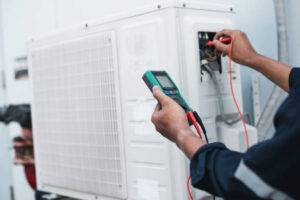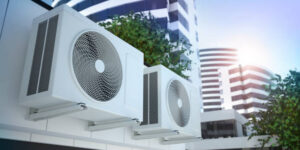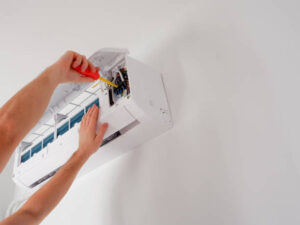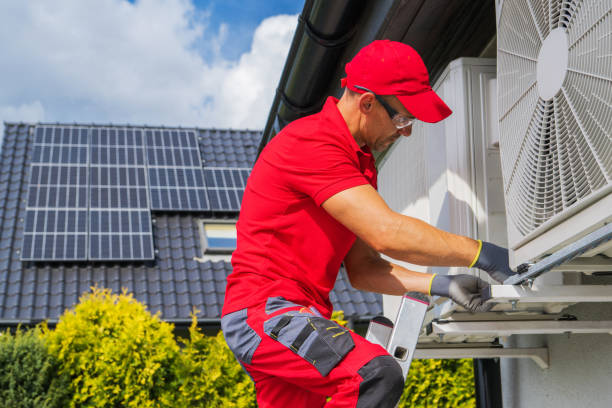HVAC systems, often overshadowed by the more visible components of a home or building, are the unsung heroes of comfort and air quality. Yet, they carve out their niche with unmatched efficiency and adaptability. This unique role distinguishes HVAC systems as a critical category in the realm of building and home maintenance, offering a specialized experience that marks them as essential in their own right.
Key types of HVAC systems include Split Systems, Hybrid Systems, Ductless Systems, and Packaged Heating and Air Systems, each known for their distinct advantages. Single Zone and Multi-Zone HVAC systems also stand out, offering tailored solutions for diverse spaces. Diving deeper, each type of HVAC system presents its own set of benefits, operational methods, environmental impacts, and recommendations for maintenance.
The following sections will explore these aspects in detail, providing a deeper understanding of what makes HVAC systems a pivotal element in creating comfortable and healthy indoor environments.
What is HVAC?

HVAC stands for Heating, Ventilation, and Air Conditioning. It’s a system that makes our homes and buildings cozy in winter and cool in summer. Besides managing temperature, HVAC systems also ensure we’re breathing clean air by filtering out pollutants and maintaining humidity levels.
This system is a blend of technology and engineering marvels, designed to provide thermal comfort and acceptable indoor air quality. Whether it’s a small home or a large commercial building, an HVAC system plays a crucial role in our daily comfort and health.
Read more: What is HVAC?
How does HVAC provide heating?
HVAC systems heat our spaces through a process involving furnaces and heat exchangers. The furnace burns fuel or uses electricity to create heat, which is then transferred to air or water in the heat exchanger. This warm air or water is distributed throughout the building via ductwork, radiators, or underfloor heating systems.
This method ensures that heat is evenly spread, making indoor spaces comfortable during cold weather. The system’s efficiency in heating comes from its ability to use various energy sources and distribute warmth effectively.
Furnace operation
A furnace operates by burning fuel, such as gas or oil, or using electricity to generate heat. This heat is then efficiently transferred to the air or water that circulates throughout the space.
Combustion, heat exchangers, and blowers
During combustion, fuel is ignited, producing heat. This heat is captured by a heat exchanger, heating air or water without direct contact with combustion gases. Blowers then propel this warmed air through the system or circulate the heated water to various parts of the building.
Heat distribution methods
The system distributes the warmed air or water using various methods to ensure even heating. These methods include forced air through ducts, radiators that emit heat into the room, and underfloor heating systems that radiate heat upwards.
Ductwork, radiators, and underfloor heating
Ductwork is a network of tubes that channels warmed air throughout the building, with vents in different rooms. Radiators, typically found in older constructions, heat the surrounding air via hot water circulating within them. Underfloor heating involves coils or pipes beneath the floor surface, offering even heat distribution and a unique level of comfort.
How does HVAC provide cooling?

HVAC systems keep our spaces cool through the air conditioner operation, which relies on the refrigerant cycle. This cycle includes compression, condensation, expansion, and evaporation of a refrigerant to absorb heat from the indoor air and release it outdoors. The cool air is then distributed throughout the building using ducted air systems or ductless mini-splits.
These cooling methods ensure that indoor spaces remain comfortable even during the hottest days, making HVAC systems essential for maintaining a pleasant indoor environment.
Air conditioner operation
Air conditioners cool our environments by cycling refrigerant through a sophisticated system of coils, compressors, and evaporators. This process efficiently extracts indoor heat and expels it outside, effectively lowering the indoor temperature.
Refrigerant cycle: compression, condensation, expansion, and evaporation
The refrigerant cycle involves four key phases: compression raises the refrigerant’s temperature; condensation occurs as the refrigerant passes through condenser coils, releasing heat outdoors; expansion cools the refrigerant down; and evaporation in the evaporator coils absorbs indoor heat, cooling the air.
Cool air distribution methods
After cooling, air is distributed throughout the building using different methods. These strategies ensure efficient and even cooling across various spaces, maintaining a consistently comfortable environment.
Ducted air and ductless mini-splits
Ducted air systems channel cooled air through a series of ducts, reaching every part of the building. Ductless mini-splits, alternatively, offer targeted cooling to specific areas without requiring ductwork, providing an efficient and flexible cooling solution.
What is the role of ventilation in HVAC?
Ventilation in HVAC systems plays a crucial role in maintaining indoor air quality by ensuring a constant exchange of indoor and outdoor air. This process helps remove stale, contaminated air and replace it with fresh, clean air. Ventilation also assists in controlling humidity levels, reducing the accumulation of pollutants, and preventing mold growth.
By integrating air exchange processes with filters, such as HEPA filters and activated carbon filters, HVAC systems can significantly improve the air we breathe indoors, contributing to healthier and more comfortable living and working environments.
Air exchange process
The air exchange process in HVAC systems is crucial for maintaining a healthy indoor environment. It ensures the continuous circulation of air, allowing fresh air to enter while expelling stale, contaminated air.
Intake of fresh air and expulsion of stale air
HVAC systems are designed to draw in fresh air from the outside, condition it, and distribute it throughout the indoor space. This process is balanced with the expulsion of stale indoor air, effectively preventing the accumulation of pollutants and unpleasant odors.
Filtering and air quality improvement
As air moves through an HVAC system, it is filtered to remove dust, pollen, and other airborne contaminants. This filtration process plays a significant role in improving indoor air quality, making indoor environments safer and more comfortable for occupants.
HEPA filters and activated and carbon filters
HEPA filters and activated carbon filters represent advanced filtration technologies within HVAC systems. HEPA filters are exceptionally efficient at trapping microscopic particles, whereas activated carbon filters specialize in absorbing gases and odors, significantly enhancing air quality.
How is HVAC controlled?

HVAC systems are controlled through various types of thermostats that allow users to set and maintain desired temperatures within their spaces. From simple, non-programmable thermostats to advanced, programmable, and smart HVAC systems, these controls offer different levels of automation and efficiency. Programmable thermostats can be set to adjust temperatures according to a schedule, while smart thermostats offer the convenience of being controlled remotely via internet-connected devices.
This flexibility in control not only enhances comfort but also improves energy efficiency by ensuring HVAC systems operate only when needed, contributing to lower energy bills and a reduced environmental impact.
Thermostats
Thermostats serve as the central control for HVAC systems, enabling users to define their ideal indoor temperature settings. They are crucial for initiating heating and cooling cycles based on user preferences.
Programmable and non-programmable
Programmable thermostats allow for the creation of temperature schedules, facilitating automatic adjustments to the indoor climate at specified times. Non-programmable thermostats, while simpler, require manual setting adjustments but offer ease of use and reliability.
Smart HVAC systems
Smart HVAC systems elevate climate control with advanced features such as learning capabilities and remote operation. These systems adapt to user habits and preferences to optimize efficiency and comfort without manual intervention.
Internet-connected and app-controlled
Featuring internet connectivity, these sophisticated systems can be managed through smartphone apps, granting users the ability to adjust their HVAC settings remotely. This level of connectivity provides unmatched convenience, enabling control over the indoor environment from any location.
What are common types of HVAC systems?
Several common types of HVAC systems cater to different needs and spaces, including Split Systems, Hybrid Systems, Ductless Systems, and Packaged Heating and Air Systems. Split Systems are the most traditional, featuring separate indoor and outdoor units. Hybrid Systems combine the efficiency of heat pumps with the power of traditional furnaces, adapting to changing temperatures seamlessly.
Ductless Systems, or mini-splits, offer a flexible solution for spaces where conventional ducted systems aren’t feasible. Lastly, Packaged Heating and Air Systems house all components in a single unit, typically installed outdoors, making them ideal for smaller spaces or homes without basements. Each type offers unique advantages, allowing for customization based on specific comfort needs, space requirements, and energy efficiency goals.
Split systems
Split systems are characterized by their separate indoor and outdoor units. The indoor unit is responsible for air distribution and filtration, while the outdoor unit focuses on cooling and compressing the refrigerant.
Separate indoor and outdoor units
This setup allows for efficient operation, with the outdoor unit expelling heat during cooling cycles and the indoor unit distributing conditioned air throughout the building.
Hybrid systems
Hybrid systems blend the advantages of traditional furnaces with those of heat pump systems. They intelligently switch between burning fossil fuels and using electricity based on the outside temperature, optimizing both energy use and indoor comfort.
Combines traditional and heat pump systems
These innovative systems offer the best of both worlds, providing energy-efficient heating and cooling by automatically selecting the most cost-effective operation mode according to external conditions and internal demands.
Ductless systems
Ductless systems, also known as mini-splits, eliminate the need for ductwork. They feature individual room units, making them an excellent choice for targeted heating and cooling in specific areas without the need for extensive ductwork modifications.
No ductwork required, individual room units
Ductless systems are particularly suited for older buildings, additions, or any space where ductwork installation is challenging or prohibitively expensive.
Packaged heating and air systems
Packaged heating and air systems consolidate all heating and cooling components into a single outdoor unit. This compact design simplifies installation and maintenance while saving valuable indoor space.
Single unit, typically installed outdoors
Installing the unit outdoors not only maximizes indoor space but also minimizes indoor noise, offering a quiet and space-efficient solution for smaller homes or commercial spaces.
How to maintain an HVAC system

Maintaining an HVAC system involves regular cleaning, filter replacement, and professional inspections to ensure optimal performance and longevity. Cleaning of coils and fan blades helps maintain efficiency while replacing filters regularly can prevent dust and allergens from circulating in the air. Professional inspections, ideally conducted annually, can identify and address potential issues before they escalate into costly repairs.
By adhering to these maintenance practices, homeowners and building managers can ensure their HVAC systems run smoothly, providing comfortable indoor environments year-round.
Regular cleaning
Regular cleaning is vital for maintaining the efficiency of an HVAC system. It involves the removal of dust and debris that can obstruct airflow and degrade system performance.
Cleaning of coils and fan blades
Attention to coils and fan blades is critical, as dirt buildup can significantly impair a system’s efficiency. Clean coils and blades ensure optimal airflow and system functionality.
Filter replacement
Regular filter replacement is crucial for maintaining high air quality and smooth system operation. Clogged filters can lead to increased energy consumption and reduced system longevity.
Types of filters and frequency of replacement
Various types of filters—including fiberglass, pleated, and HEPA—require replacement at different intervals. Typically, it’s recommended to replace filters every 30 to 90 days, depending on the filter type and usage.
Professional inspections
Professional inspections conducted by qualified technicians can identify and rectify issues early on, preventing expensive repairs. These inspections thoroughly evaluate all system components for potential wear and tear.
Annual check-ups and seasonal servicing
Annual check-ups and seasonal servicing are essential for ensuring an HVAC system is ready for the seasonal demands ahead, optimizing performance for the summer heat or winter cold.
Related Readings: HOW TO CLEAN HVAC DUCTS AND IMPROVE AIR QUALITY
Final Thoughts
HVAC systems are the backbone of indoor comfort, seamlessly managing temperature, air quality, and humidity. By understanding their operation and maintenance, we can ensure these systems run efficiently, providing a healthy and comfortable living environment. Investing in regular upkeep and modern controls can significantly enhance their performance and longevity.
Take the first step towards optimal indoor comfort by scheduling a professional HVAC inspection today with Callidus Air!

